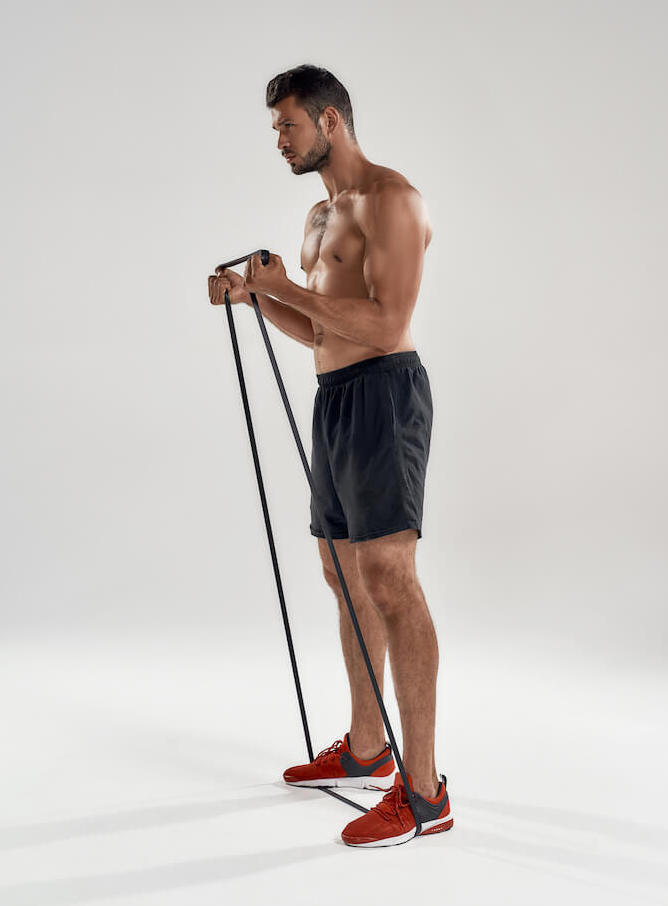Products You May Like
Expert strength and fitness coach Jack Hanrahan explains how to use resistance bands for strength training at home…
If you’ve never considered resistance band training, let this be your reason to start.
Training with resistance bands involves pulling or pushing against the tension contained within the band when it is stretched, and it’s a form of training that comes with numerous benefits and some important advantages over lifting weights.
RELATED CONTENT:
Benefits of using resistance bands
So, why might someone start resistance band training? For personal trainer Jack Hanrahan, they’ve had a special place in his gym bag for more than a decade of workouts.
“They are a fantastic tool for training at home and incredibly versatile,” he says.
Ideally, they would be used alongside barbells, dumbbells and kettlebells, but the message is that, by themselves, they are still an underrated and seriously effective tool.
RELATED: Best Dumbbell Exercises for Every Body Part
One of their advantages is cost, Hanrahan explains:
“A pair of 30-40kg dumbbells is pretty pricey, but you can get two or three resistance bands that would be £50 or something, and they’re going to generate a similar amount of tension when they’re stretched.”
RELATED: Best Dumbbells for Home Workouts
As well as that, they weigh next to nothing and – unlike 40kg weights – can be packed into your bag when you next go on holiday (if such a time ever occurs).
You can also take them down to the park safe in the knowledge that you won’t look as odd as someone doing the same thing with a huge set of dumbbells.
While you might worry that you’re going to let go of the band and smack yourself hard in your beautiful face, resistance band training should be safer for your body than lifting heavy weights.
That’s because the tension of the band changes according to where you are in your movement.
“If you think about a deadlift,” says Hanrahan, “the load is consistent through the whole range. So your lower back is potentially compromised in that bottom position, where the muscles are being loaded. But with a band, there’s very low tension there, because the band is not very stretched.”
How to use resistance bands to build muscle
That’s partly why bands have gained a reputation for being exclusively used for rehabilitative purposes. But they are far more flexible than that, says Hanrahan, and can certainly be used to effectively build muscle.
In fact, a study published in the Journal of Strength and Conditioning Research showed that using a combination of bands and weights is more productive than using weights exclusively.
There are two principal ways in which the body builds muscle: mechanical tension and metabolic stress.
The first, which sees muscles contract strongly when loaded with heavy weight, is less applicable for band training.
The focus with bands, therefore, is on metabolic stress: the burning you feel when a muscle is working hard for a long time. Resistance bands work particularly well for higher reps.
Hanrahan recommends 15 to 30 reps, with between 60 and 90 seconds of rest between each set.
Working out with a band is different to being in a gym and adding weights to your heart’s desire – or, rather, until you cannot lift any more weights and you collapse on the floor, a sodden mess.
So, rather than assigning a repetition range, with bands it can be better to “just work”, says Hanrahan – “keep going with perfect form until you feel like your technique is about to break down or you’re a couple of reps shy of failure.”
Another tip he passes on is that slowing down your reps will increase time under tension and can keep continuous tension on the muscle you are targeting.
How to structure resistance band workouts
In terms of structuring band workouts, he applies the same theory he would to a regular workout. You could choose either to work your whole body, or divide your workouts into upper and lower body workouts.
“If you’re going to do two to three strength sessions per week, you do full body,” he says. “If you’re going to do four or more, you could do an upper/lower split.”
The latter is what Hanrahan does: he focuses on legs on Mondays and Thursdays, and on his upper body on Tuesdays and Fridays.
He recommends splitting the upper-body workout into push and pull patterns, and the leg workout into an exercise from the categories of squat, hinge and lunge.
How to choose the right resistance band
Typically, the bands come in one length, 41 inches, and various thicknesses.
Of the three main widths of band – 0.5 inches, 1 inch, and 1.75 inches – Hanrahan recommends the 1 inch as the most versatile, but it’s a good idea to have a couple of options: a thicker one for your legs and a lighter one for your upper body.
“The thicker they are, the more tension they will generate when they’re stretched,” says Hanrahan.
Words: Ralph Jones
